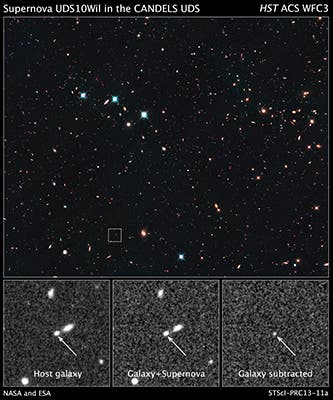Astronomers using NASA’s Hubble Space Telescope have come across the farthest supernova of its type found thus far – a type Ia supernova which exploded some 10 billion years ago. The discovery isn’t just about setting milestones, however. Supernovae act as beacons that help astronomers measure the expansion of the Universe, and this latest finding will help deepen our understanding, especially concerning dark energy.
Dubbed UDS10Wil and nicknamed SN Wilson after the former American President Woodrow Wilson, it took 10 billion years for the light of this violent star explosion to reach Earth.
“This new distance record holder opens a window into the early universe, offering important new insights into how these stars explode,” said David O. Jones of Johns Hopkins University in Baltimore, Md., an astronomer and lead author on the paper detailing the discovery. “We can test theories about how reliable these detonations are for understanding the evolution of the universe and its expansion.”
Because of the Universe’s expansion, the distance light needed to reach Earth from the dawn of the supernova doesn’t equal the actual distance SN Wilson is located at this time with respect to our planet. This is why despite SN Wilson is just four percent more distant than the previous oldest supernova, it’s still 350 million years older than any star explosion.

The find was made part of ongoing project of the Hubble team, which first began in 2010, tasked with finding faraway Type Ia supernovae and determining whether they have changed during the 13.8 billion years since the explosive birth of the universe. Since then, the team has uncovered more than 100 supernovae of all types and distances, looking back in time from 2.4 billion years to more than 10 billion years. This wouldn’t had been possible were it not for the extremely sharp Wide Field Camera 3 instrument aboard Hubble, which peers in near-infrared light for signs of supernovae and verifies their distance with spectroscopy.
[RELATED] New type of supernova discovered – the third
A distant yardstick
Because they’re some of the brightest spots in the Universe, supernovae provide accurate and reliable reference points for measuring the expansion of the Universe and better our understanding of dark energy – the driving force that pushes the Universe to expand. Type Ia supernovae are especially useful since they’re the most brightest.
“The Type Ia supernovae give us the most precise yardstick ever built, but we’re not quite sure if it always measures exactly a yard,” said team member Steve Rodney of Johns Hopkins University. “The more we understand these supernovae, the more precise our cosmic yardstick will become.”
Moreover, the discovery of ever distant Type Ia supernovae helps unravel how they form. Currently, scientists are divided in opinions between two formation models. In one model the explosion is caused by a merger between two white dwarfs. In another model, a white dwarf gradually feeds off its partner, a normal star, and explodes when it accretes too much mass. An abrupt decline in Type Ia supernova blasts between 7.5 billion years ago and 10 billion years ago hints in favor of the two white dwarf merger model, because it predicts that most stars in the early universe are too young to become Type Ia supernovae.
“If supernovae were popcorn, the question is how long before they start popping?” Riess said. “You may have different theories about what is going on in the kernel. If you see when the first kernels popped and how often they popped, it tells you something important about the process of popping corn.”
Findings were reported in the journal The Astrophysical Journal.






